Investigating Extreme Snowfall Changes in China Based on an Ensemble of High-Resolution Regional Climate Models
Abstract
1. Introduction
2. Data and Methodology
3. Results
4. Discussions
5. Conclusions
Author Contributions
Funding
Institutional Review Board Statement
Informed Consent Statement
Data Availability Statement
Acknowledgments
Conflicts of Interest
References
- Jennings, K.S.; Molotch, N.P. Snowfall Fraction, Cold Content, and Energy Balance Changes Drive Differential Response to Simulated Warming in an Alpine and Subalpine Snowpack. Front. Earth Sci. 2020, 8, 186. [Google Scholar] [CrossRef]
- Beniston, M.; Keller, F.; Koffi, B.; Goyette, S. Estimates of snow accumulation and volume in the Swiss Alps under changing climatic conditions. Theor. Appl. Climatol. 2003, 76, 125–140. [Google Scholar] [CrossRef]
- Jennings, K.S.; Molotch, N.P. The sensitivity of modeled snow accumulation and melt to precipitation phase methods across a climatic gradient. Hydrol. Earth Syst. Sci. 2019, 23, 3765–3786. [Google Scholar] [CrossRef]
- Davenport, F.V.; Herrera-Estrada, J.E.; Burke, M.; Diffenbaugh, N.S. Flood Size Increases Nonlinearly Across the Western United States in Response to Lower Snow-Precipitation Ratios. Water Resour. Res. 2020, 56, e2019WR025571. [Google Scholar] [CrossRef]
- Tuel, A.; El Moçayd, N.; Hasnaoui, M.D.; Eltahir, E.A.B. Future projections of High Atlas snowpack and runoff under climate change. Hydrol. Earth Syst. Sci. 2022, 26, 571–588. [Google Scholar] [CrossRef]
- Ji, Z.; Kang, S. Projection of snow cover changes over China under RCP scenarios. Clim. Dyn. 2013, 41, 589–600. [Google Scholar] [CrossRef]
- Marty, C.; Blanchet, J. Long-term changes in annual maximum snow depth and snowfall in Switzerland based on extreme value statistics. Clim. Chang. 2012, 111, 705–721. [Google Scholar] [CrossRef]
- Krasting, J.P.; Broccoli, A.; Dixon, K.; Lanzante, J. Future Changes in Northern Hemisphere Snowfall. J. Clim. 2013, 26, 7813–7828. [Google Scholar] [CrossRef]
- Wu, X.; Che, T.; Li, X.; Wang, N.; Yang, X. Slower Snowmelt in Spring Along with Climate Warming Across the Northern Hemisphere. Geophys. Res. Lett. 2018, 45, 12331–12339. [Google Scholar] [CrossRef]
- Gorman, P.A.O. Contrasting responses of mean and extreme snowfall to climate change. Nature 2014, 512, 416–420. [Google Scholar] [CrossRef]
- López-Moreno, J.I.; Goyette, S.; Vicente-Serrano, S.M.; Beniston, M. Effects of climate change on the intensity and frequency of heavy snowfall events in the Pyrenees. Clim. Chang. 2011, 105, 489–508. [Google Scholar] [CrossRef]
- Wang, H.; Yu, E.; Yang, S. An exceptionally heavy snowfall in Northeast China large scale An exceptionally heavy snowfall in Northeast China: Large-scale circulation anomalies and hindcast of the NCAR WRF model. Meteorol. Atmos. Phys. 2011, 113, 11–25. [Google Scholar] [CrossRef]
- Lute, A.C.; Abatzoglou, J.T.; Hegewisch, K.C. Projected changes in snowfall extremes and interannual variability of snowfall in the western United States. Water Resour. Res. 2014, 51, 960–972. [Google Scholar] [CrossRef]
- Ghafarian, P.; Delju, A.H.; Tajbakhsh, S.; Penchah, M.M. Simulation of the role of Caspian Sea surface temperature and air temperature on precipitation intensity in lake-effect snow. J. Atmos. Sol. Terr. Phys. 2021, 225, 105777. [Google Scholar] [CrossRef]
- Liu, Y.; Guo, B.; Lu, M.; Zang, W.; Yu, T.; Chen, D. Quantitative distinction of the relative actions of climate change and human activities on vegetation evolution in the Yellow River Basin of China during 1981–2019. J. Arid. Land 2023, 15, 91–108. [Google Scholar] [CrossRef]
- Wilby, R.L. A Review of Climate Change impacts on the built environment. Built Environ. 2007, 33, 31–45. [Google Scholar] [CrossRef]
- Sturm, M.; Taras, B.; Liston, G.E.; Derksen, C.; Jonas, T.; Lea, J. Estimating Snow Water Equivalent Using Snow Depth Data and Climate Classes. J. Hydrometeorol. 2010, 11, 1380–1394. [Google Scholar] [CrossRef]
- CAN/CSA-S502-14; Managing Changing Snow Load Risks for Buildings in Canada’s North. CSA Group: Toronto, ON, Canada, 2014.
- Guo, B.; Yang, F.; Fan, Y.; Zang, W. The dominant driving factors of rocky desertification and their variations in typical mountainous karst areas of southwest China in the context of global change. Catena 2023, 220, 106674. [Google Scholar] [CrossRef]
- Liu, Y. An analysis of the changing characteristics of snowfall in the East Asia based on CMIP5. J. Glaciol. Geocryol. 2014, 6, 1345–1352. [Google Scholar]
- Gleason, K.E.; McConnell, J.R.; Arienzo, M.M.; Chellman, N.; Calvin, W.M. Four-fold increase in solar forcing on snow in western U.S. burned forests since 1999. Nat. Commun. 2019, 10, 2026. [Google Scholar] [CrossRef]
- Steger, C.; Kotlarski, S.; Jonas, T.; Schär, C. Alpine snow cover in a changing climate: A regional climate model perspective. Clim. Dyn. 2013, 41, 735–754. [Google Scholar] [CrossRef]
- De Vries, H.; Lenderink, G.; van Meijgaard, E. Future snowfall in western and central Europe projectedwith a high-resolution regional climate model ensemble. Geophys. Res. Lett. 2014, 41, 4294–4299. [Google Scholar] [CrossRef]
- Van Pelt, W.J.J.; Kohler, J.; Liston, G.E.; Hagen, J.O.; Luks, B.; Reijmer, C.H.; Pohjola, V.A. Multidecadal climate and seasonal snow conditions in Svalbard. J. Geophys. Res. Earth Surf. 2016, 121, 2100–2117. [Google Scholar] [CrossRef]
- Frei, P.; Kotlarski, S.; Liniger, M.A.; Schär, C. Future snowfall in the Alps: Projections based on the EURO-CORDEX regional climate models. Cryosphere 2018, 12, 1–24. [Google Scholar] [CrossRef]
- Krinner, G.; Derksen, C.; Essery, R.; Flanner, M.; Hagemann, S.; Clark, M.; Hall, A.; Rott, H.; Brutel-Vuilmet, C.; Kim, H.; et al. ESM-SnowMIP: Assessing snow models and quantifying snow-related climate feedbacks. Geosci. Model Dev. 2018, 11, 5027–5049. [Google Scholar] [CrossRef]
- Le Roux, E.; Evin, G.; Eckert, N.; Blanchet, J.; Morin, S. Elevation-dependent trends in extreme snowfall in the French Alps from 1959 to 2019. Cryosphere 2021, 15, 4335–4356. [Google Scholar] [CrossRef]
- Tuel, A.; Chehbouni, A.; Eltahir, E.A.B. Dynamics of seasonal snowpack over the High Atlas. J. Hydrol. 2021, 595, 125657. [Google Scholar] [CrossRef]
- Marty, C.; Schlögl, S.; Bavay, M.; Lehning, M. How much can we save? Impact of different emission scenarios on future snow cover in the Alps. Cryosphere 2017, 11, 517–529. [Google Scholar] [CrossRef]
- Le Roux, E.; Evin, G.; Eckert, N.; Blanchet, J.; Morin, S. Non-stationary extreme value analysis of ground snow loads in the French Alps: A comparison with building standards. Nat. Hazards Earth Syst. Sci. 2020, 20, 2961–2977. [Google Scholar] [CrossRef]
- Bonsoms, J.; Gonzalez, S.; Prohom, M.; Esteban, P.; Salvador-Franch, F.; López-Moreno, J.I.; Oliva, M. Spatio-temporal patterns of snow in the Catalan Pyrenees (NE Iberia). Int. J. Climatol. 2021, 41, 5676–5697. [Google Scholar] [CrossRef]
- López-Moreno, J.I.; Soubeyroux, J.M.; Gascoin, S.; Alonso-Gonzalez, E.; Durán-Gómez, N.; Lafaysse, M.; Vernay, M.; Carmagnola, C.; Morin, S. Long-term trends (1958–2017) in snow cover duration and depth in the Pyrenees. Int. J. Climatol. 2020, 40, 6122–6136. [Google Scholar] [CrossRef]
- Buisan, S.T.; López-Moreno, J.; Saz, M.; Kochendorfer, J. Impact of weather type variability on winter precipitation, temperature and annual snowpack in the Spanish Pyrenees. Clim. Res. 2016, 69, 79–92. [Google Scholar] [CrossRef]
- Faranda, D. An attempt to explain recent changes in European snowfall extremes. Weather Clim. Dyn. 2020, 1, 445–458. [Google Scholar] [CrossRef]
- Günther, D.; Marke, T.; Essery, R.; Strasser, U. Uncertainties in Snowpack Simulations—Assessing the Impact of Model Structure, Parameter Choice, and Forcing Data Error on Point-Scale Energy Balance Snow Model Performance. Water Resour. Res. 2019, 55, 2779–2800. [Google Scholar] [CrossRef]
- Yılmaz, Y.A.; Aalstad, K.; Sen, O.L. Multiple Remotely Sensed Lines of Evidence for a Depleting Seasonal Snowpack in the Near East. Remote Sens. 2019, 11, 483. [Google Scholar] [CrossRef]
- Suzuki, K.; Zupanski, M. Uncertainty in solid precipitation and snow depth prediction for Siberia using the Noah and Noah-MP land surface models. Front. Earth Sci. 2018, 12, 672–682. [Google Scholar] [CrossRef]
- Musselman, K.N.; Clark, M.P.; Liu, C.; Ikeda, K.; Rasmussen, R. Slower snowmelt in a warmer world. Nat. Clim. Chang. 2017, 7, 214–219. [Google Scholar] [CrossRef]
- Alonso-González, E.; Gutmann, E.; Aalstad, K.; Fayad, A.; Bouchet, M.; Gascoin, S. Snowpack dynamics in the Lebanese mountains from quasi-dynamically downscaled ERA5 reanalysis updated by assimilating remotely sensed fractional snow-covered area. Hydrol. Earth Syst. Sci. 2021, 25, 4455–4471. [Google Scholar] [CrossRef]
- Alonso-González, E.; Gutmann, E.; Aalstad, K.; Fayad, A.; Bouchet, M.; Gascoin, S. Impact of North Atlantic Oscillation on the Snowpack in Iberian Peninsula Mountains. Water 2020, 12, 105. [Google Scholar] [CrossRef]
- Alonso-González, E.; López-Moreno, J.I.; Navarro-Serrano, F.M.; Revuelto, J. Snow climatology for the mountains in the Iberian Peninsula using satellite imagery and simulations with dynamically downscaled reanalysis data. Int. J. Climatol. 2020, 40, 477–491. [Google Scholar] [CrossRef]
- Zhang, B.; Wang, S.; Zhu, J. A weighted ensemble of regional climate projections for exploring the spatiotemporal evolution of multidimensional drought risks in a changing climate. Clim. Dyn. 2022, 58, 49–68. [Google Scholar] [CrossRef]
- Deser, C.; Phillips, A.; Bourdette, V.; Teng, H. Uncertainty in climate change projections: The role of internal variability. Clim. Dyn. 2012, 38, 527–546. [Google Scholar] [CrossRef]
- Giorgi, F. Introduction to the special issue: The phase I CORDEX RegCM4 hyper-matrix (CREMA) experiment. Clim. Chang. 2014, 125, 1–5. [Google Scholar] [CrossRef]
- Giorgi, F. Changes in extremes and hydroclimatic regimes in the CREMA ensemble projections. Clim. Chang. 2014, 125, 39–51. [Google Scholar] [CrossRef]
- Yatagai, A.; Maeda, M.; Khadgarai, S.; Masuda, M.; Xie, P. End of the Day (EOD) Judgment for Daily Rain-Gauge Data. Atmosphere 2020, 11, 772. [Google Scholar] [CrossRef]
- Min, S.; Zhang, X.; Zwiers, F.W.; Hegerl, G.C. Human contribution to more-intense precipitation extremes. Nature 2011, 470, 378–381. [Google Scholar] [CrossRef]
- Ma, Q.; Keyimu, M.; Li, X.; Wu, S.; Zeng, F.; Lin, L. Climate and elevation control snow depth and snow phenology on the Tibetan Plateau. J. Hydrol. 2023, 617, 128938. [Google Scholar] [CrossRef]
- Diffenbaugh, N.S.; Scherer, M.; Ashfaq, M. Response of snow-dependent hydrologic extremes to continued global warming. Nat. Clim. Chang. 2013, 3, 379–384. [Google Scholar] [CrossRef]
- Kunkel, K.E.; Karl, T.R.; Brooks, H.; Kossin, J.; Lawrimore, J.H.; Arndt, D.; Bosart, L.F.; Changnon, D.; Cutter, S.; Doesken, N.J.; et al. Monitoring and Understanding Trends in Extreme Storms: State of Knowledge. Bull. Am. Meteorol. Soc. 2013, 94, 499–514. [Google Scholar] [CrossRef]
- Kodra, E.; Steinhaeuser, K.; Ganguly, A.R. Persisting cold extremes under 21st-century warming scenarios. Geophys. Res. Lett. 2011, 38. [Google Scholar] [CrossRef]
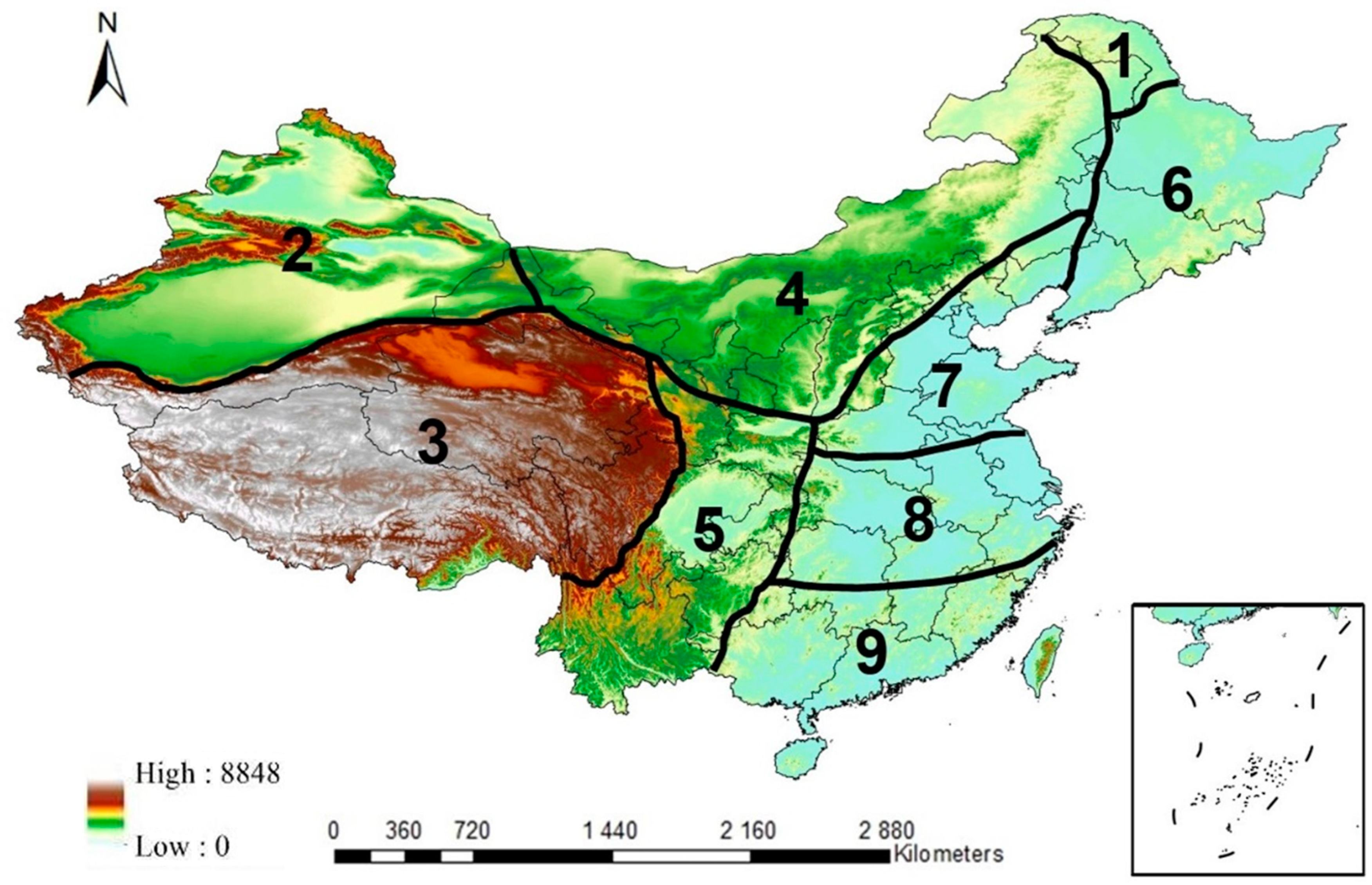
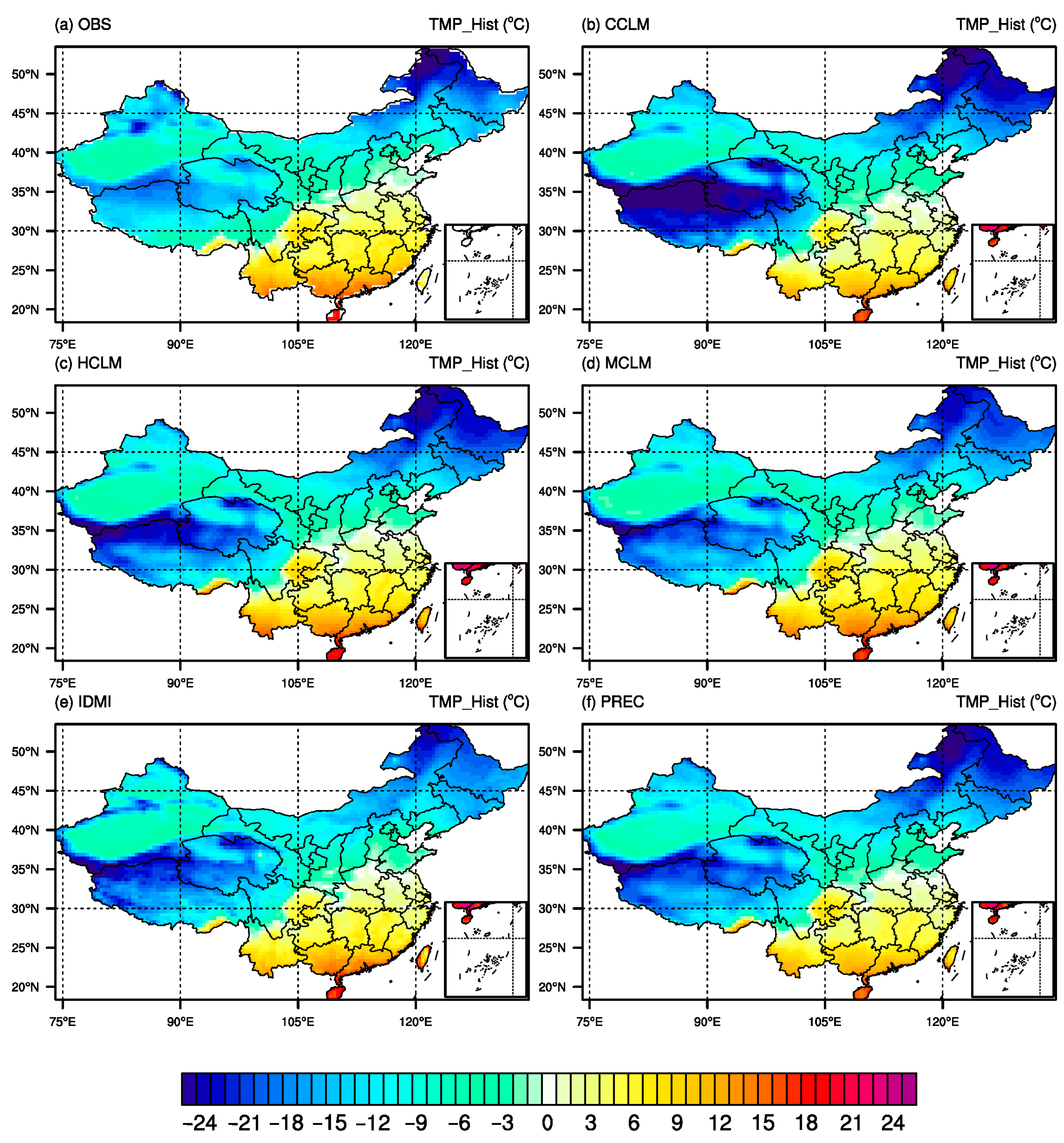
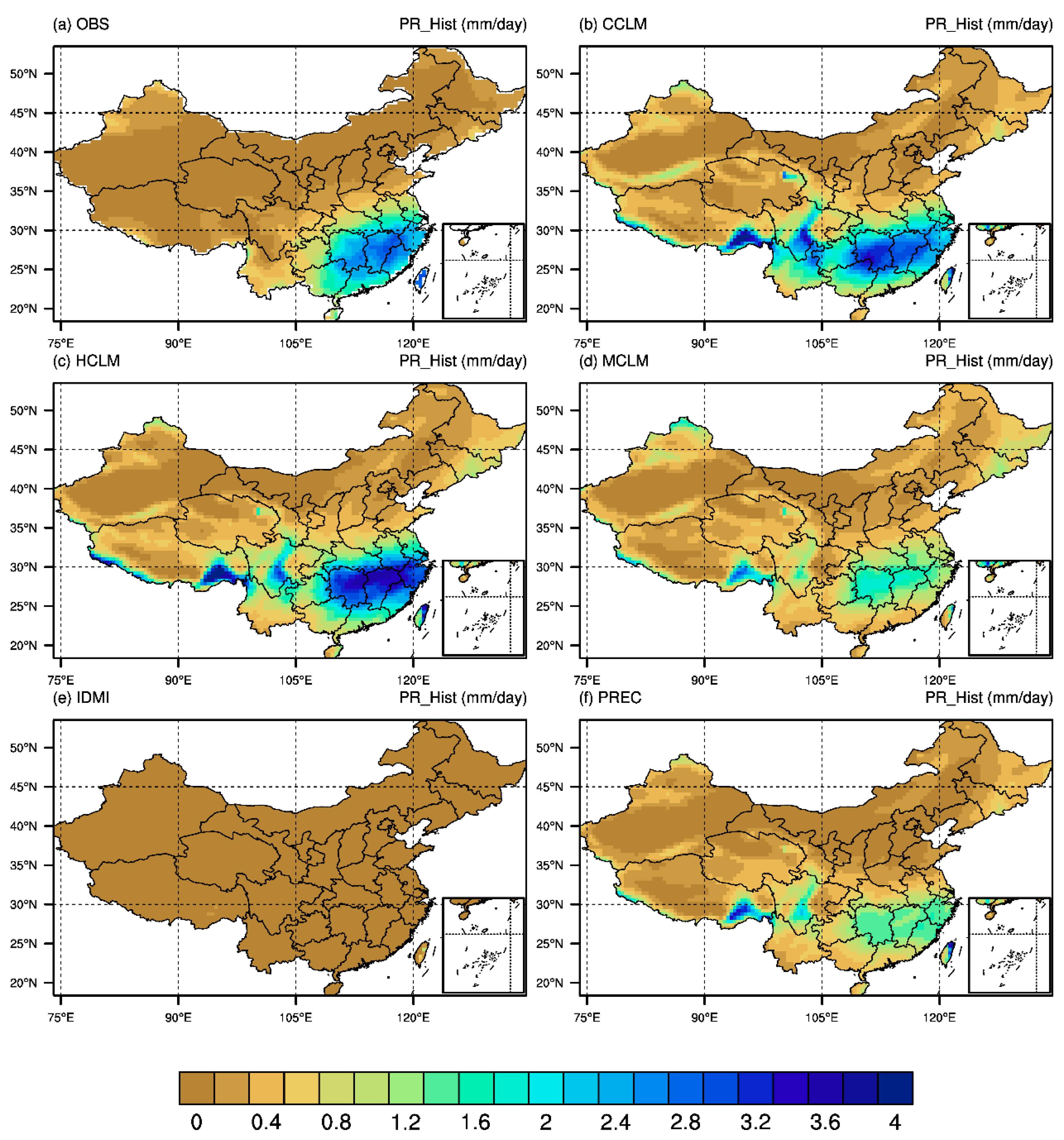


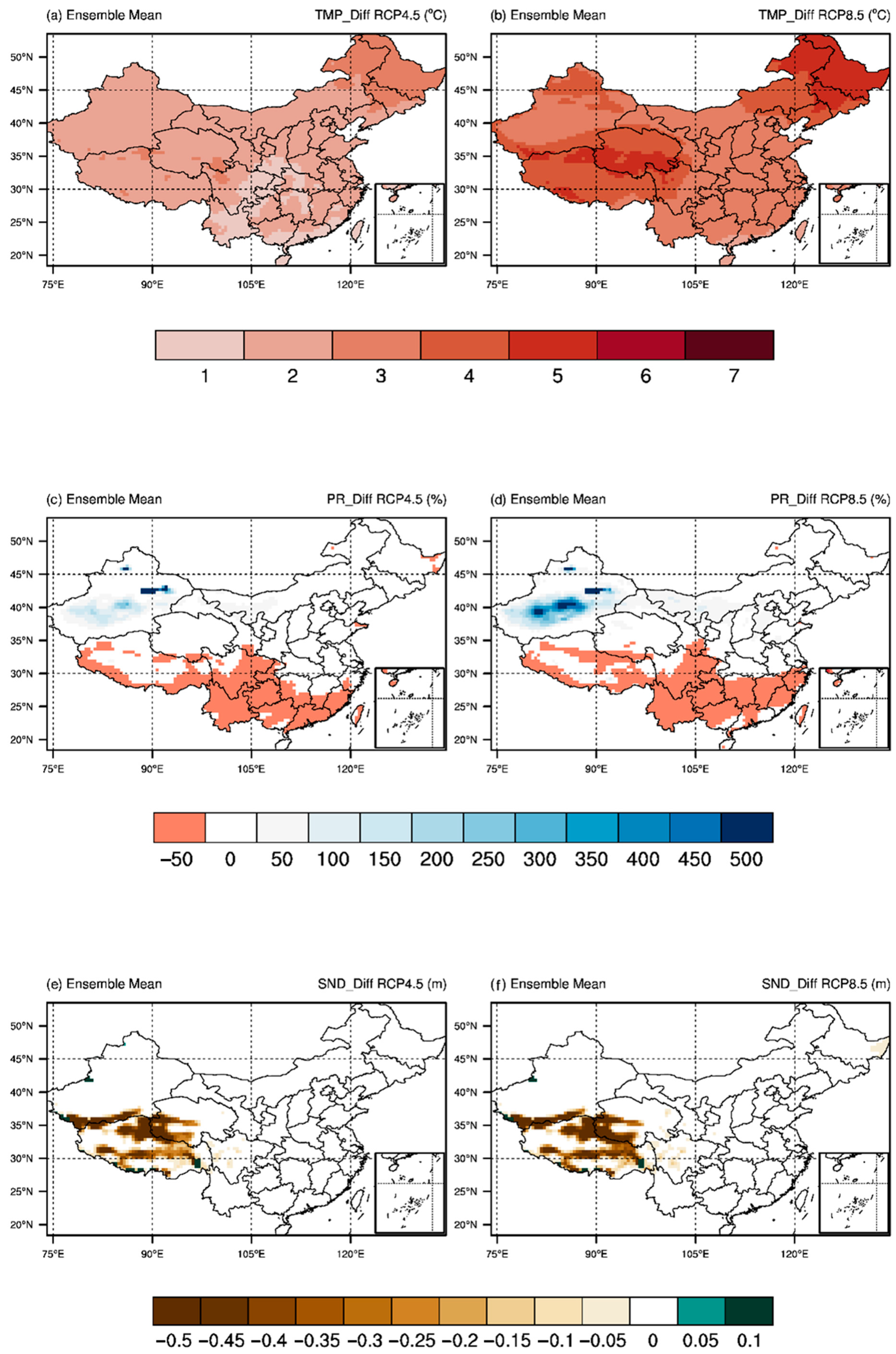
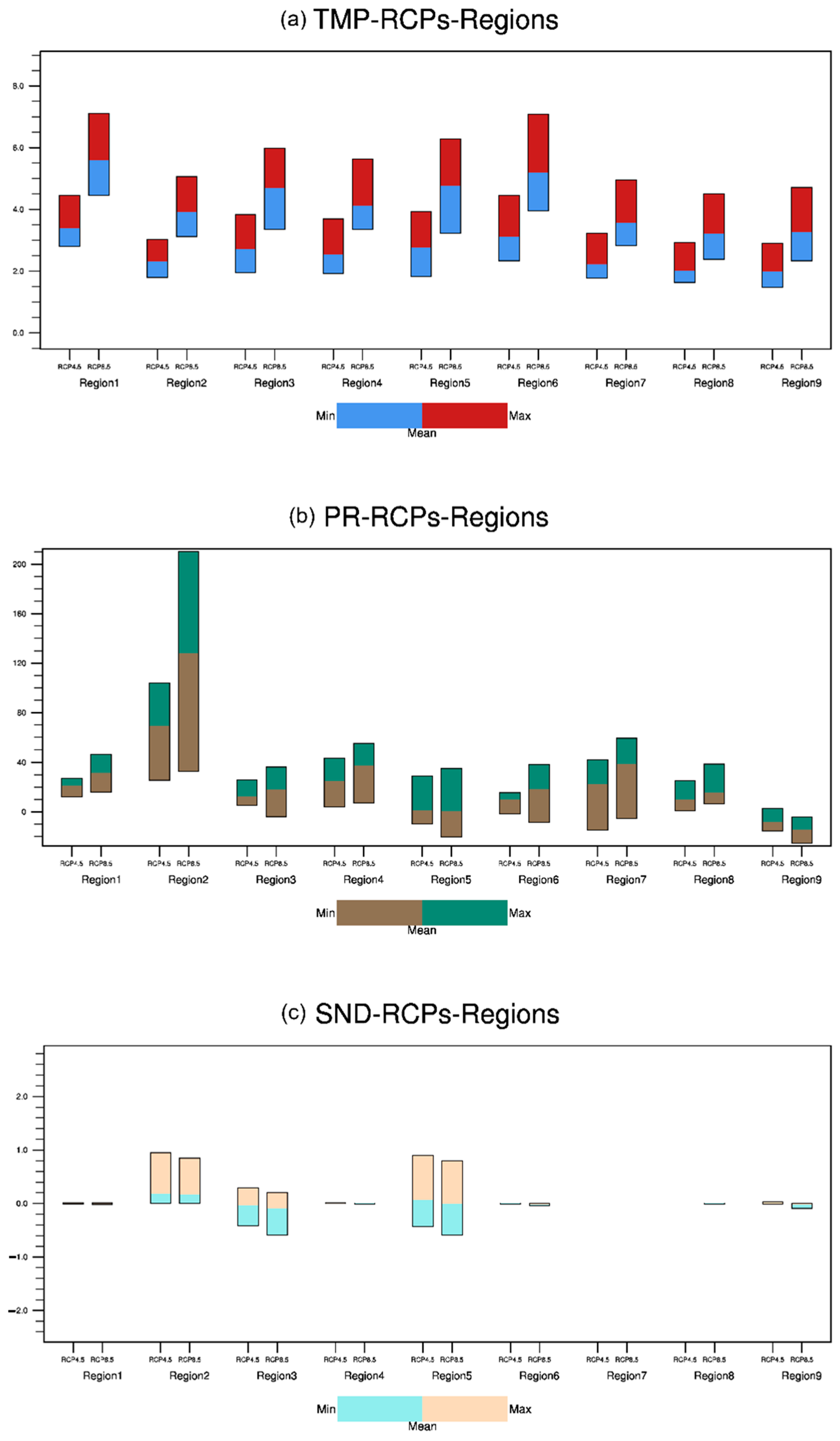
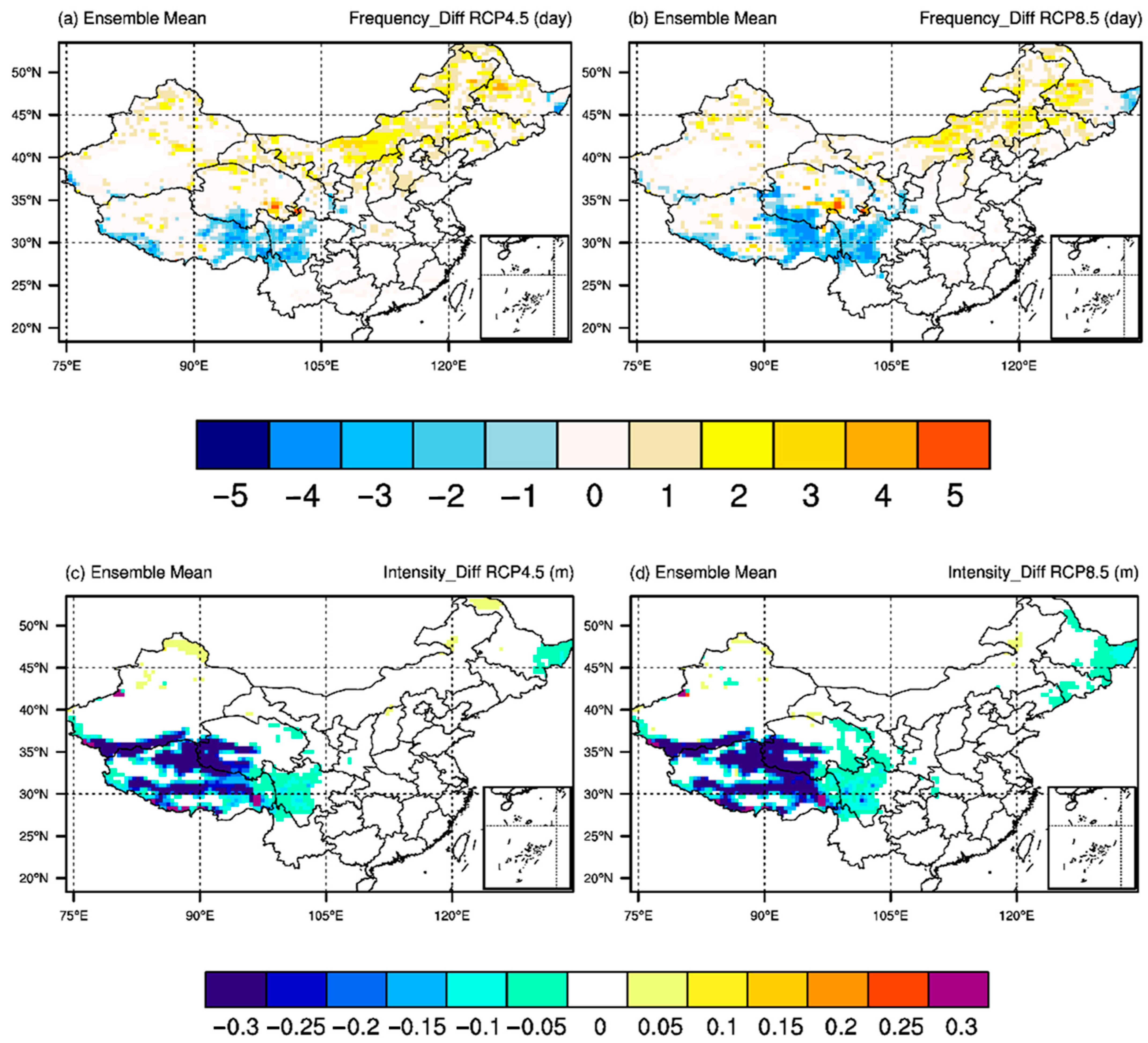
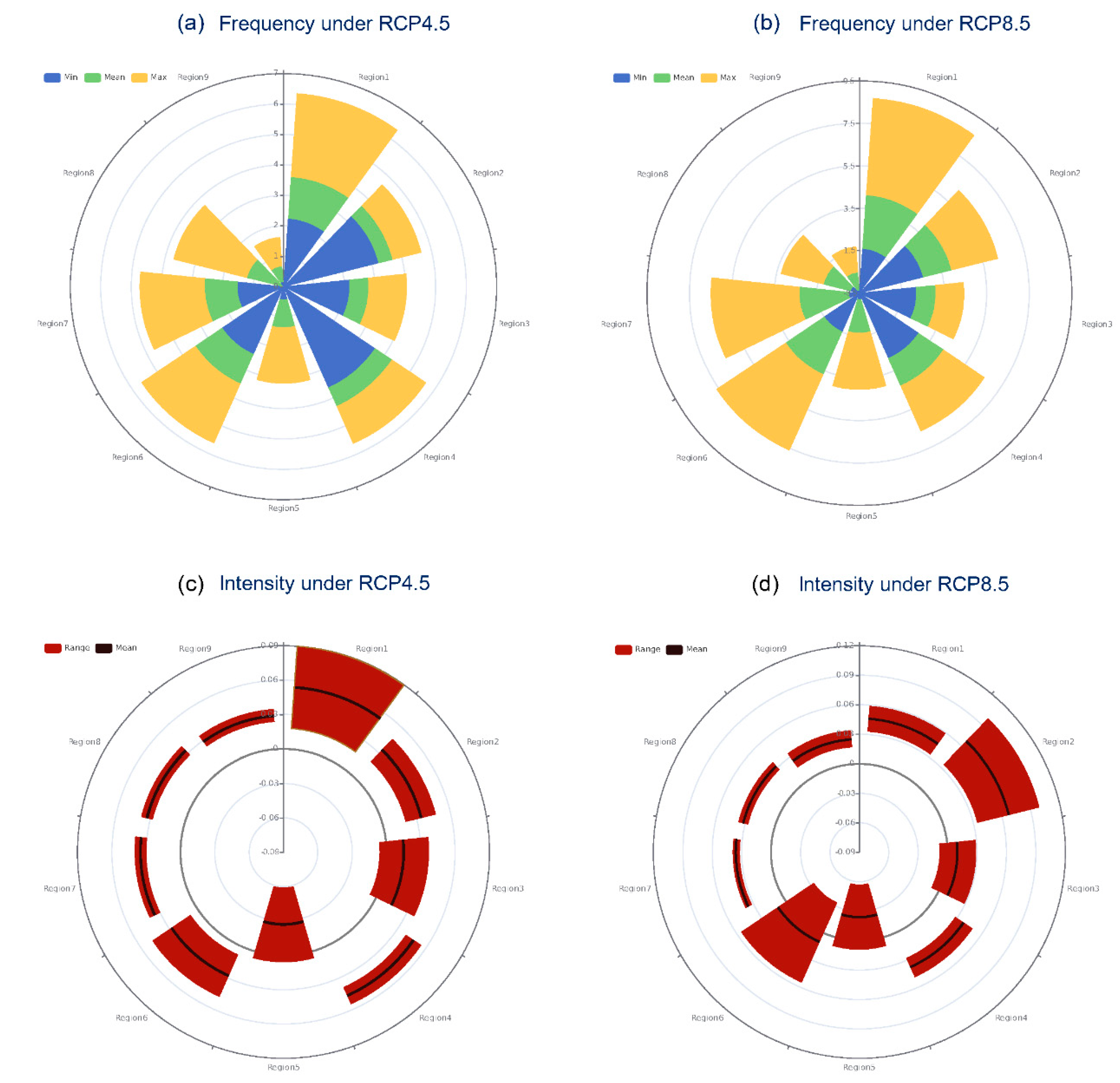
| RCMs | Resolutions | Institutes | Driving GCMs | Abbreviations |
|---|---|---|---|---|
| CLMcom-CCLM5-0-2 | 0.5° × 0.5° | The Climate Limited-area Modeling Community | CNRM-CERFACS-CNRM-CM5 | CCLM |
| 0.5° × 0.5° | HadGEM2-ES | HCLM | ||
| 0.5° × 0.5° | MPI-M-MPI-ESM-LR | MCLM | ||
| DMI-HIRHAM5 | 0.5° × 0.5° | Danish Meteorological Institute | ICHEC-EC-EARTH | IDMI |
| PRECIS | 0.5° × 0.5° | Met Office Hadley Centre | HadGEM2-ES | PREC |
Disclaimer/Publisher’s Note: The statements, opinions and data contained in all publications are solely those of the individual author(s) and contributor(s) and not of MDPI and/or the editor(s). MDPI and/or the editor(s) disclaim responsibility for any injury to people or property resulting from any ideas, methods, instructions or products referred to in the content. |
© 2023 by the authors. Licensee MDPI, Basel, Switzerland. This article is an open access article distributed under the terms and conditions of the Creative Commons Attribution (CC BY) license (https://creativecommons.org/licenses/by/4.0/).
Share and Cite
Zhu, J.; Weng, X.; Guo, B.; Zeng, X.; Dong, C. Investigating Extreme Snowfall Changes in China Based on an Ensemble of High-Resolution Regional Climate Models. Sustainability 2023, 15, 3878. https://doi.org/10.3390/su15053878
Zhu J, Weng X, Guo B, Zeng X, Dong C. Investigating Extreme Snowfall Changes in China Based on an Ensemble of High-Resolution Regional Climate Models. Sustainability. 2023; 15(5):3878. https://doi.org/10.3390/su15053878
Chicago/Turabian StyleZhu, Jinxin, Xuerou Weng, Bing Guo, Xueting Zeng, and Cong Dong. 2023. "Investigating Extreme Snowfall Changes in China Based on an Ensemble of High-Resolution Regional Climate Models" Sustainability 15, no. 5: 3878. https://doi.org/10.3390/su15053878
APA StyleZhu, J., Weng, X., Guo, B., Zeng, X., & Dong, C. (2023). Investigating Extreme Snowfall Changes in China Based on an Ensemble of High-Resolution Regional Climate Models. Sustainability, 15(5), 3878. https://doi.org/10.3390/su15053878









